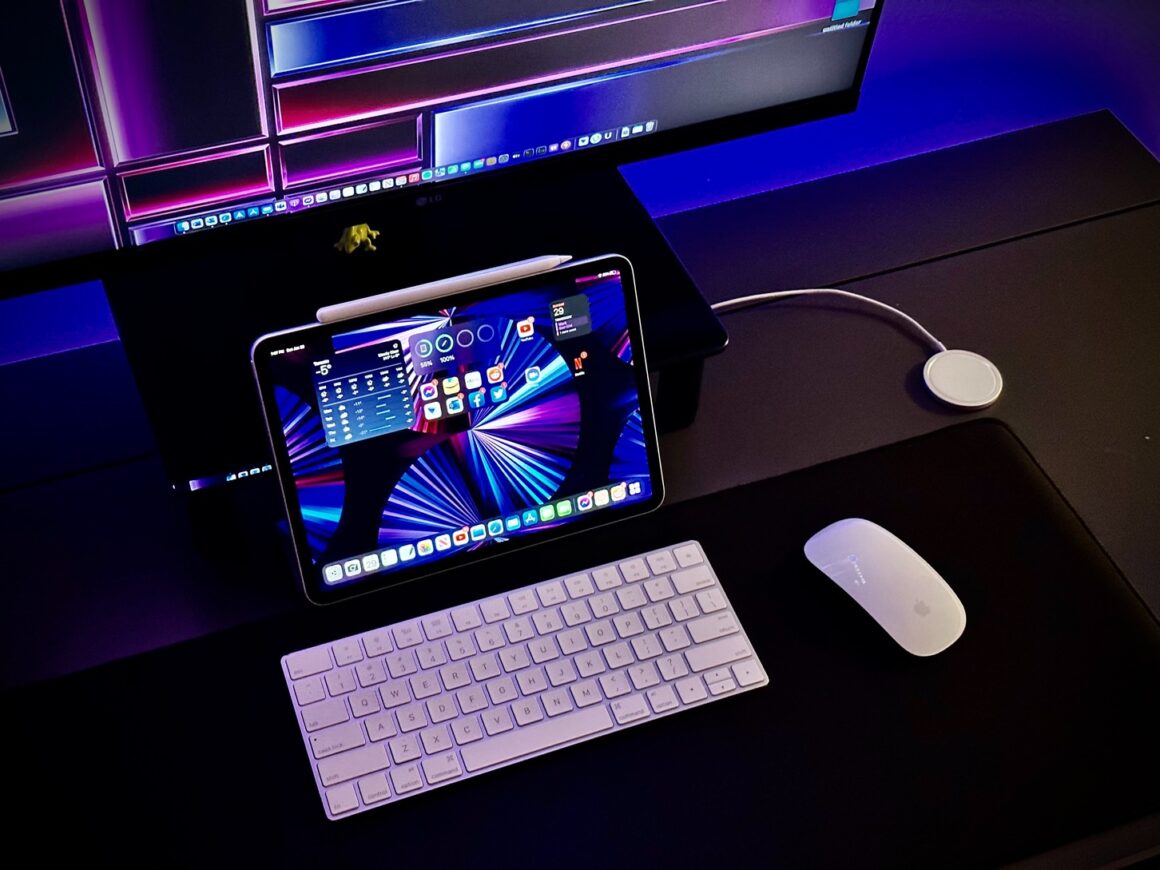Introduction
In today’s fast-paced digital world, efficiency and productivity are not just buzzwords but essential elements for professional success. One technological advancement that has significantly contributed to enhancing these aspects is the use of multiple monitors. Once a luxury, multi-screen setups have now become a staple in various work environments, offering a myriad of benefits that go beyond mere convenience.
The concept of using more than one monitor might seem like an extravagance to the uninitiated, but it’s a game-changer for many professionals. From software developers to graphic designers, and from stock traders to video editors, the adoption of dual or triple monitor setups has seen a significant rise. This surge in popularity is not without reason; multiple monitors enable users to expand their digital workspace, streamline workflows, and significantly increase their productivity.
One of the most immediate benefits of using multiple monitors is the expanded visual real estate. Imagine having the ability to view multiple applications simultaneously without the need to constantly switch between tabs or windows. This setup allows for a more organized and efficient workspace, where one can have a code editor on one screen, a web browser on another, and perhaps a communication tool on a third. For graphic designers, it could mean having their design software on one screen and a reference image or a tutorial on another. The possibilities are endless and highly customizable based on individual work needs.
The rise in the popularity of multiple monitors is also a response to the increasing complexity of professional tasks. In a world where multitasking has become the norm, having additional screens allows professionals to keep track of various processes and information streams with ease. Whether it’s monitoring live data feeds, editing large-scale video projects, or managing extensive software development environments, multiple monitors offer a level of efficiency that a single screen simply cannot match.
Moreover, the evolution of technology and the decreasing cost of monitors have made multi-screen setups more accessible than ever before. What was once the domain of high-end professions or enthusiasts is now a viable option for the average user, be it for work or leisure. The result is a growing trend that’s reshaping how we interact with our digital environments, making multi-tasking more manageable and less time-consuming.
In the following sections, we will delve deeper into how you can set up and optimize your multi-monitor workspace, specific tips tailored for different professional needs, ergonomic considerations, and troubleshooting advice to ensure that you get the most out of this transformative setup.
Section 1: Understanding the Basics of a Multiple Monitor Setup
1.1: What is a Multiple Monitors Setup?
At its core, a multiple monitors setup involves using more than one display device (like computer monitors, TVs, or a mix of these) connected to a single computer. This setup creates an extended desktop, allowing the user to stretch their computer workspace across several screens. The monitors can be arranged side by side, stacked one above the other, or positioned in any way that suits the user’s preference and workspace limitations.
This setup is achieved through various means, depending on the capabilities of the computer’s graphics card and available connectivity options. Most modern graphics cards support multiple outputs, making it relatively easy to set up dual or triple monitors. Moreover, with the advent of technologies like USB-C and Thunderbolt, even laptops, which traditionally supported only a single external display, can now power multiple monitors.
The general concept here is to extend the digital workspace. Instead of working within the confines of a single screen, multiple monitors allow users to spread out their applications, tools, and documents across several screens. This extension of digital space provides a broader visual canvas and reduces the need to toggle between multiple windows on a single screen.
1.2: The Advantages of Dual or Triple Monitor Setups
The advantages of incorporating a dual or triple monitor setup are manifold, particularly in terms of productivity, multitasking, and efficiency.
Increased Productivity: One of the most significant benefits of a multi-monitor setup is the noticeable boost in productivity. According to various studies, the use of multiple monitors can increase productivity by 20-30%. This is largely because it reduces the time spent switching between applications, leading to more efficient workflow management.
Enhanced Multitasking: With more screen real estate, multitasking becomes more manageable. For instance, a programmer can have their code on one screen, a debugging tool on another, and a web browser for research on the third. This setup minimizes the need to minimize and maximize different windows, allowing for smoother transitions between tasks.
Efficiency in Professional Tasks: Different professions can leverage the advantages of multiple monitors in unique ways. Graphic designers can work on a design in one monitor while referencing material or using a tool palette on another. Financial traders can monitor multiple live feeds simultaneously, and video editors can edit on one screen while previewing the output in real-time on another.
Reduced Digital Clutter: By expanding the workspace, users can organize their digital environment more effectively. This organization leads to less clutter on each screen, making it easier to focus on specific tasks without distractions.
Flexibility and Customization: Multiple monitor setups offer the flexibility to customize the workspace according to individual preferences and job requirements. Each user can decide how to divide their tasks across screens, creating a personalized work environment that best suits their workflow.
In the next sections, we will explore the practical aspects of setting up multiple monitors, including choosing the right hardware, ergonomic considerations, and specific tips for various professional uses.
Section 2: Essential Tips for Setting Up Your Monitors
2.1: Choosing the Right Monitors
When embarking on creating a multiple monitor setup, the first step is selecting the right monitors. This choice can significantly impact your experience and productivity. Here are some key factors to consider:
- Size: The size of the monitors should be based on your workspace and the distance from where you’ll be viewing them. Larger screens offer more space but require a larger desk and more room to view comfortably. Generally, 24 to 27 inches is a sweet spot for most users.
- Resolution: Higher resolution monitors provide sharper images and more screen real estate. For most tasks, a 1080p resolution is sufficient, but those involved in detailed graphic work or coding might benefit from 4K resolution for clearer text and images.
- Refresh Rate: This is particularly important for gaming or video editing. A higher refresh rate (like 120Hz or 144Hz) ensures smoother motion. For general productivity tasks, a standard 60Hz monitor is typically adequate.
- Panel Type: IPS (In-Plane Switching) panels offer better viewing angles and color reproduction, making them ideal for graphic design and video editing, while TN (Twisted Nematic) panels are more affordable and offer faster response times, suitable for gaming.
- Additional Features: Consider if you need features like built-in speakers, USB hubs, or specific types of inputs like HDMI, DisplayPort, or USB-C.
2.2: Optimal Monitor Configuration
Once you have your monitors, setting them up ergonomically is crucial for comfort and productivity:
- Placement: Position the monitors at eye level. The top of the screen should be at or slightly below eye level. This placement reduces neck strain.
- Viewing Angle and Distance: Monitors should be positioned to avoid glare and should ideally form a semi-circle around your main viewpoint. The ideal viewing distance is about an arm’s length away.
- Alignment: If you use one monitor more frequently, place it directly in front of you and the secondary monitor to the side. For equal use, center them in front of you.
- Orientation: Depending on your work, you might benefit from rotating one of your monitors to a portrait orientation, which is great for reading or coding.
2.3: Technical Setup
Setting up your monitors technically involves a few important steps:
- Connectivity: Check your computer’s graphics card to see how many monitors it can support and the types of connections it offers (HDMI, DisplayPort, DVI, VGA). You may need adapters if your monitors don’t match the available ports.
- Software Settings: Within your operating system, you’ll need to configure your displays. This usually involves right-clicking on the desktop, selecting “Display settings,” and then arranging your monitors to mirror how they are set up physically. You can also adjust resolutions and orientations here.
- Troubleshooting Common Issues: If you encounter issues like one monitor not being detected, check your cable connections first. For resolution or color discrepancies, adjust settings within your computer’s display settings. Remember, driver updates for your graphics card can also solve many display issues.
Setting up your monitors properly is a critical step in creating an efficient and comfortable workspace. With the right hardware and setup, you can ensure a seamless and productive multi-monitor experience.
Section 3: Maximizing Efficiency with Your Setup
3.1: Organizing Your Workspace
An organized workspace is key to maximizing the benefits of your multiple monitor setup. Effective screen organization and window management can significantly enhance your workflow and productivity. Here are some tips to optimize your digital workspace:
- Designate Specific Tasks to Each Monitor: Assign a specific role or task to each screen. For example, use one monitor primarily for coding, another for debugging, and a third for reference materials or communication tools. This clear segregation helps in reducing time spent switching between tasks.
- Utilize Virtual Desktops: Most operating systems allow the creation of multiple virtual desktops. This feature can be particularly useful in a multi-monitor setup, allowing you to have different desktops for different types of work or projects.
- Window Management Tools: Consider using window management tools that enable you to quickly organize and resize windows. These tools often provide shortcuts to move windows between monitors or to snap them to specific areas of the screen.
- Consistent Arrangement of Frequently Used Applications: Place your most frequently used applications in the same position on your screens. Consistency in where you place certain tools or documents can reduce cognitive load and increase efficiency.
- Minimize Clutter: While multiple monitors provide more screen real estate, it’s important to avoid clutter. Keep only necessary windows open and use desktop organization tools to keep files and shortcuts in order.
3.2: Productivity Tools and Software Enhancements
Enhancing your multi-monitor setup with the right tools and software can further streamline your workflow. Here are some noteworthy tools and enhancements for managing multiple displays:
- Display Fusion or Ultramon: These are powerful tools for Windows that offer advanced features for multi-monitor setups, such as different wallpapers on each monitor, precise window management, and custom hotkeys.
- Magnet (for macOS): This tool helps in managing windows by snapping them into organized tiles, which is extremely helpful when working with multiple applications across several screens.
- Input Director or Synergy: If you’re using more than one computer with your multi-monitor setup, these tools allow you to control all computers with a single keyboard and mouse, seamlessly moving the cursor between screens and machines.
- Monitor Calibration Software: For those in graphic design or video editing, color consistency across monitors is crucial. Monitor calibration software can help ensure that colors and brightness levels are consistent across all screens.
- Taskbar Extensions: Some tools extend or duplicate the taskbar across monitors, making it easier to manage and switch between applications on different screens.
By organizing your workspace effectively and employing the right productivity tools, you can make the most out of your multiple monitor setup, turning it into a powerhouse of efficiency and productivity.
Section 4: Specific Tips for Different User Groups
4.1: For Software Developers and Coders
For software developers and coders, multiple monitors can transform the coding and debugging process into a more efficient and less frustrating experience. Here’s how you can leverage multiple screens:
- Primary Screen for Coding: Use your main monitor for your primary coding environment. This screen should host your main IDE (Integrated Development Environment) or code editor.
- Secondary Screen for Debugging and Reference: The second monitor is ideal for running debugging tools, viewing application outputs, or monitoring performance. It can also be used to display documentation, API references, or Stack Overflow for quick access to solutions.
- Tertiary Screen for Additional Tools: If you have a third monitor, it can host your version control systems, database interfaces, or any other ancillary tools that support your development process.
- Organize by Task: Dedicate each monitor to a specific aspect of your work – coding, debugging, and referencing – to minimize context switching and enhance focus.
4.2: For Graphic Designers and Video Editors
Graphic designers and video editors need vast visual spaces for their creative work, and multiple monitors provide just that. Here’s how these professionals can benefit from extra screen space:
- Main Working Canvas: Use one monitor as your primary workspace, where you do most of your designing or video editing. This screen should ideally be of the highest resolution and color accuracy.
- Toolboxes and Palettes: Utilize a secondary screen for toolboxes, layers, and color palettes. This arrangement keeps your main workspace uncluttered and provides more room for creative work.
- Reference Material and Previews: Use an additional monitor for viewing reference materials, inspirations, or for real-time previews of your designs or videos. This setup aids in immediate comparison and adjustments.
- Efficient Workflow: Having separate screens for different aspects of your work streamlines your workflow, making it easier to switch between tools and see the impact of your edits instantly.
4.3: For Gamers and Streamers
Dual monitors offer a significant advantage for gamers and streamers, enhancing both play and interaction with the audience:
- Primary Gaming Screen: The main monitor should be used for gaming. This screen should have a high refresh rate and quick response time for the best gaming experience.
- Secondary Screen for Streaming and Communication: Use the second monitor for your streaming interface, chat windows, and social media. This allows you to interact with your audience without interrupting your game.
- Monitoring Streaming Software: Keep an eye on your streaming software, like OBS or XSplit, on the secondary screen to manage your stream’s settings and view without alt-tabbing out of your game.
- Balancing Game and Interaction: A dual-monitor setup helps maintain a balance between focusing on the game and engaging with viewers, providing a more enjoyable experience for both the streamer and the audience.
By tailoring the multi-monitor setup to their specific needs, software developers, graphic designers, video editors, gamers, and streamers can greatly enhance the efficiency and enjoyment of their work and hobbies.
Section 5: Ergonomics and Health Considerations
5.1: Ergonomic Tips for Multi-Monitor Setups
While multiple monitors can enhance productivity, it’s crucial to set them up ergonomically to prevent physical strain and fatigue. Here are some tips to ensure your multi-monitor workspace is as comfortable as it is efficient:
- Proper Posture: Maintain a neutral body position with a chair that supports your lower back, feet flat on the ground, and knees at hip level. Your arms should be parallel to the floor while typing.
- Monitor Positioning: The top of the monitor screens should be at or slightly below eye level. Position your monitors so you can easily view each with minimal head movement, typically forming a gentle arc in front of you.
- Screen Brightness and Contrast: Adjust the brightness and contrast of your monitors to match the lighting of your room. This helps reduce eye strain. Avoid overly bright screens in dimly lit environments.
- Eye Care: Follow the 20-20-20 rule – every 20 minutes, look at something 20 feet away for at least 20 seconds. This practice helps reduce the risk of eye strain. Consider using monitor filters or adjusting settings to reduce blue light exposure.
- Regular Adjustments: Change your monitor setup periodically. Minor adjustments to the height, angle, or distance can prevent your body from becoming accustomed to a single, potentially harmful posture.
5.2: Balancing Work and Breaks
Adopting healthy work habits is essential to maintaining productivity and well-being in a multi-monitor environment:
- Scheduled Breaks: Use tools or apps that remind you to take short breaks every hour. These breaks are crucial for reducing muscle fatigue and mental strain.
- Physical Activity: Incorporate stretching or light exercises during breaks. This practice helps alleviate the physical stress of prolonged sitting.
- Eye Exercises: Engage in eye exercises during breaks to relieve eye muscles. Simple exercises include blinking rapidly for a few seconds or rolling your eyes in different directions.
- Mindful Work Routines: Be aware of how long you spend on specific tasks. Diversify your activities to avoid long periods of repetitive motion or focus, which can lead to strain and fatigue.
- Workspace Variation: Occasionally change your work environment if possible. This could mean working from a different room or adjusting your setup to introduce a change of scenery and posture.
By paying attention to ergonomics and balancing work with regular breaks, you can enjoy the benefits of a multi-monitor setup without compromising your physical and mental health.
Section 6: Advanced Configurations and Troubleshooting
6.1: Customizing for Advanced Users
For those looking to take their multi-monitor setups to the next level, customizing and utilizing advanced features can significantly enhance the experience. Here are some areas to explore:
- Color Calibration: Ensuring color accuracy across all monitors is crucial, especially for graphic design and video editing. Tools like Datacolor Spyder or X-Rite ColorMunki can help you achieve consistent color profiles.
- Advanced Display Settings: Dive into the display settings of your operating system to fine-tune resolutions, color depth, and refresh rates for each monitor. This can be particularly important for setups involving monitors of different sizes and resolutions.
- Third-Party Software for Task Management: Consider using advanced window management tools that provide greater control over how and where applications open by default across your monitors.
- Custom Shortcuts and Hotkeys: Many monitor management tools allow you to create custom shortcuts for moving windows between monitors or resizing them quickly. This can be a huge time saver.
- Multiple Graphics Cards: For extremely demanding tasks or a large number of monitors, consider using multiple graphics cards. This setup can provide the necessary power to ensure smooth performance across all screens.
6.2: Troubleshooting Common Multi-Monitor Issues
Even the best setups can encounter problems. Here are solutions to some common multi-monitor issues:
- Monitor Not Detected: Check your cables and ports first. If everything is connected correctly, try updating your graphics card drivers. Sometimes switching ports can also help the system recognize the monitor.
- Resolution or Color Problems: Ensure that each monitor is set to its native resolution in the display settings. If colors are off, try calibrating each monitor or reset them to factory settings.
- Performance Issues with Multiple Monitors: If your system is struggling to run multiple monitors, consider upgrading your graphics card or reducing the resolution on some monitors to lighten the load.
- Mismatched Scaling: This can occur when combining monitors with different resolutions. Adjust the scaling settings for each monitor in your operating system’s display settings to make text and icons appear consistent in size across screens.
- Software Not Behaving with Multiple Monitors: Some applications might not work well with multi-monitor setups. Check if there are updates or patches for the software, or look for alternative programs designed for multi-monitor environments.
Advanced customization and troubleshooting are key to maintaining an efficient and problem-free multi-monitor setup. With the right tools and knowledge, you can ensure that your workspace not only meets but exceeds your requirements.
Conclusion
Throughout this comprehensive guide, we’ve explored the dynamic and increasingly essential world of multiple monitor setups, covering everything from the basic principles to advanced customization and troubleshooting. Here’s a quick recap of the key points we’ve discussed:
- Understanding the Basics: We started by defining what a multiple monitors setup is and why it’s beneficial, particularly highlighting its impact on productivity, multitasking, and efficiency.
- Setting Up Your Monitors: We then delved into the crucial aspects of choosing the right monitors, emphasizing factors like size, resolution, and refresh rate, and provided tips for ergonomic placement and technical setup.
- Maximizing Efficiency: Organizing your workspace effectively and utilizing productivity tools for managing multiple displays were highlighted as key strategies for enhancing your workflow.
- Tailored Tips for Different User Groups: Specific advice was given for software developers, graphic designers, video editors, gamers, and streamers, showing how each group can uniquely benefit from a multi-monitor setup.
- Ergonomics and Health: We emphasized the importance of ergonomic practices and maintaining a balance between work and health, especially when operating in a multi-monitor environment.
- Advanced Configurations and Troubleshooting: Lastly, we covered advanced customization options for power users and common troubleshooting issues, providing solutions to ensure a smooth multi-monitor experience.
As we conclude, remember that the journey to creating an ideal multi-monitor setup is unique to each individual. The key is to experiment and find what works best for you. Whether it’s optimizing your setup for enhanced productivity, creating an ergonomic workspace, or customizing your monitors for specific tasks, each step you take should align with your personal or professional needs.
Embrace the flexibility and opportunities that multiple monitors provide. Don’t hesitate to tweak and adjust your setup as your requirements evolve. With the right configuration, a multi-monitor setup can transform your work or play experience, leading to greater efficiency, satisfaction, and overall well-being.







